Apprehensive about riding in the rain? Then this guide to cycling in the monsoons in India is for you, learn to ride, maintain and enjoy your ride!
The arrival of the monsoon brings a welcome respite from the scorching Indian summer. For many of us, the joy of seeing the monsoons clouds rolling in is like the movie Lagaan! Especially for us cyclists, as pedalling through the rain is an extremely rewarding experience. Yet, the often treacherous conditions due to poor infrastructure can be a challenge.
It ushers in a period that demands extra caution and awareness on the road. Wet roads, reduced visibility, and unpredictable weather conditions can transform a leisurely ride into a challenging experience.
But fear not, with the right preparation and approach, you can navigate the monsoon safely and enjoy the thrill of riding through rain-soaked landscapes. This guide to cycling in the monsoons equips you with essential tips for a smooth and safe experience.
Guide to Cycling in Indian Monsoons: Tips & Strategies

Gear Up for the Downpour
- Embrace Reflectivity: Invest in a high-visibility cycling jacket and reflective accessories like ankle straps. Rain can significantly reduce driver visibility, especially in modern day cars, so maximizing your presence on the road is crucial. Choose neon green or orange colours for maximum impact.
- Light Up Your Ride: Ensure your front and rear lights are in proper working order and bright enough to pierce the rain and low-light conditions. And make sure it is charged for the ride.
- Waterproof Your Belongings: Pack a waterproof backpack or pannier bags to keep your belongings dry if you are going to use your bicycle for commuting to work. A waterproof phone case is a great accessory to have on your regular morning rides.

Tread Carefully: Tyre Tips
- Tread Depth is Key: The monsoon season is not the time for worn-out tyres. Check your tyre treads regularly and ensure they have sufficient depth to channel water effectively and maintain grip on wet surfaces.
- Inflate for Control: Slightly adjust your tire pressure for monsoon riding. Run a slightly lower pressure (around 5-10 psi less than usual) to increase the tyre’s contact patch with the road, enhancing grip. Remember to adjust pressure based on your specific tyre recommendations and riding conditions.
- Consider Puncture Resistance: If you experience frequent punctures, consider investing in puncture-resistant tyres. Tubeless tyre setups are also a good option, if you ride an MTB or even a road bike with 30mm or wider tyres.
Mastering the Monsoon Ride: Techniques and Strategies
- Slow and Steady Wins the Race: Adjust your riding speed to match the conditions. Braking distances are significantly longer on wet roads, so ride slower than usual and leave ample space between yourself and other vehicles. If you have rim brakes, then be even more careful as compared to dry conditions.
- Smooth Braking is Essential: Avoid sudden braking manoeuvres, which can cause your wheels to lock and lead to skids. Apply the brakes gently and progressively, using both the front and rear brakes simultaneously.
- Maintain a Straight Line: Avoid sharp turns and sudden changes in direction, especially when riding through puddles or on slippery surfaces. Lean your body slightly into the turn for better stability.
- Beware of Hidden Hazards: Increased water flow can expose potholes, debris, and uneven road surfaces. Stay alert and scan the road ahead to avoid unexpected obstacles.
- Mind the Wind and Drafts: Monsoon winds can be unpredictable and gusty, especially if you live near the coast. Be prepared for sudden changes in wind direction. Large vehicles passing by can also create strong air drafts, so stay aware of your surroundings.
- Avoid Puddles: Puddles can hide potholes, debris, or other hazards. If you can’t avoid them, approach slowly and be prepared for an uneven surface. Ride through the center of the puddle where the road is likely to be more stable.
- Use Lower Gears: Using lower gears can help you maintain better control of your bike in slippery conditions. It allows for smoother pedalling and reduces the chance of your wheels slipping.
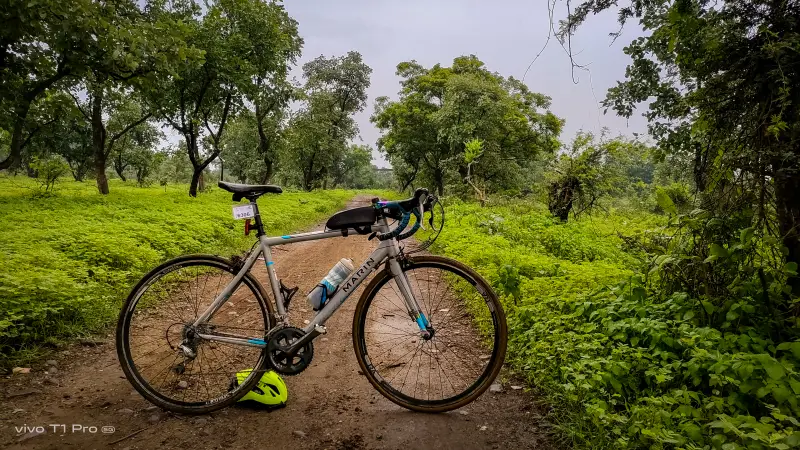
Planning Your Monsoon Ride
- Track the Weather: Before heading out, check the latest weather forecast. Avoid riding during heavy downpours or thunderstorms when visibility is severely compromised. Opt for periods of lighter rain or brief breaks in the monsoon showers.
- Choose Your Route Wisely: Stick to familiar routes with good road surfaces and drainage. Avoid low-lying areas prone to flooding and opt for wider roads with better visibility.
- Plan for Shelter: Be prepared for sudden downpours. Identify potential shelter options along your route, such as bus stops, shops, or underpasses, where you can wait out heavy rain if necessary.
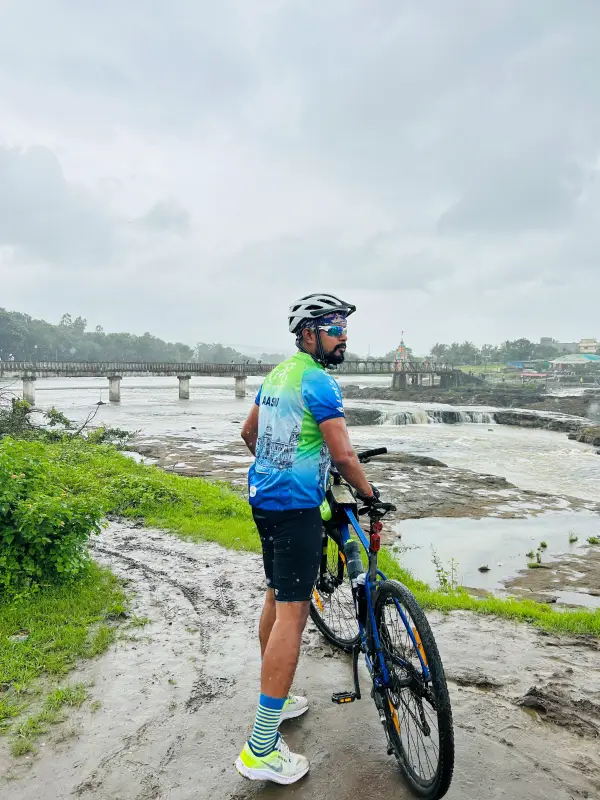
Maintaining Your Monsoon Machine
- Post-Ride Wash and Lube: After a monsoon ride, thoroughly clean your bike to remove dirt, mud, and debris. Pay particular attention to your drivetrain (chain, cassette, derailleurs) and brakes. Apply a good quality chain lubricant which is made for wet conditions, to prevent rust and ensure smooth operation.
- Check Your Brakes Regularly: Wet conditions can affect braking performance. Regularly inspect your brake pads for wear and tear, and ensure proper brake alignment for optimal stopping power.
- Dry Your Gear: Hang your wet clothes and gear to dry as soon as possible to prevent mildew and bad odours. Waterproof clothing should be washed according to the manufacturer’s instructions to maintain its effectiveness.
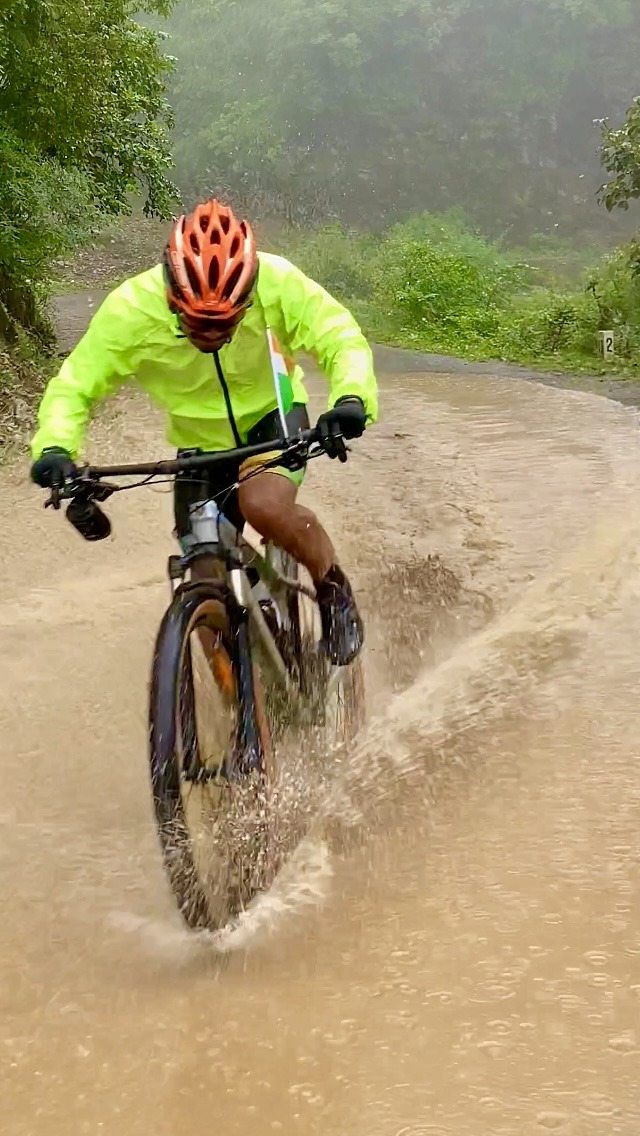
Additional Tips for a Safe Ride
- Invest in Fenders: Fenders will help keep you and your bike dry by deflecting water spray from the road. This not only improves comfort but also enhances visibility by preventing mud splatter on your lights and reflectors.
- Be Mindful of Other Road Users: Monsoon conditions affect all road users. Be extra cautious around pedestrians, vehicles, and other cyclists. Everyone’s reaction time is slower in the wet, so give plenty of warning and space when overtaking or turning.
- Carry Emergency Essentials: Pack a basic repair kit with tools to fix a flat tyre or tighten those loose bolts. Consider carrying a small, lightweight rain poncho for unexpected downpours.
- Stay Hydrated and Nourished: Even though it’s cooler, you still need to stay hydrated. Carry water and snacks with you. Rain can sometimes lead to a drop in temperature, so dress in layers to stay warm.
- Know When to Stop: Sometimes, conditions can become too dangerous to continue riding. If visibility drops drastically, the rain becomes too heavy, or you feel unsafe, find a safe place to stop and wait for the weather to improve.

Environmental Considerations
1. Respect Nature: Monsoon is a time when nature thrives. Be respectful of your surroundings. Avoid riding through fields or forest trails that can be easily damaged by heavy rainfall.
2. Be Aware of Wildlife: Monsoon season often brings wildlife closer to roads and trails. Be alert and give any animals you encounter plenty of space. Reptiles are known to make way for higher ground, which is often the road itself.
3. Prevent Pollution: Be conscious of not leaving any litter behind. The monsoons can wash trash into waterways, causing pollution. Always carry your waste with you until you find a proper disposal method. Though this should be followed, irrespective of the weather conditions!
Community and Resources
1. Join a Cycling Group: Riding with others can be safer and more enjoyable. Look for local cycling groups or clubs that ride close to you. They can offer support, route suggestions, and safety tips.
2. Use Technology: Various apps and online platforms provide real-time weather updates.
3. Learn Basic Repairs: Knowing how to fix a flat tyre or adjust your brakes can be invaluable, especially in the middle of a ride. Carry a basic repair kit with you and practice these skills.
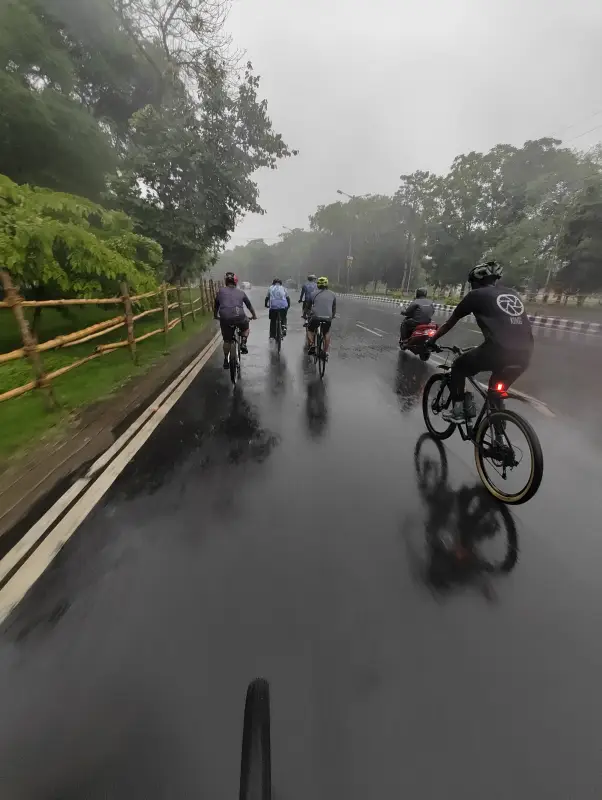
Conclusion
Cycling during the Indian monsoons presents unique challenges but can also be incredibly rewarding. It is also time consuming, as you need to factor in the time to clean your bike, clothes and yourself up after ever ride. Consider it when you plan your cycling during the day.
For some, it might still not be possible to head out and ride in the rain. For those of you who can’t, read this Guide to Indoor Cycle Training.
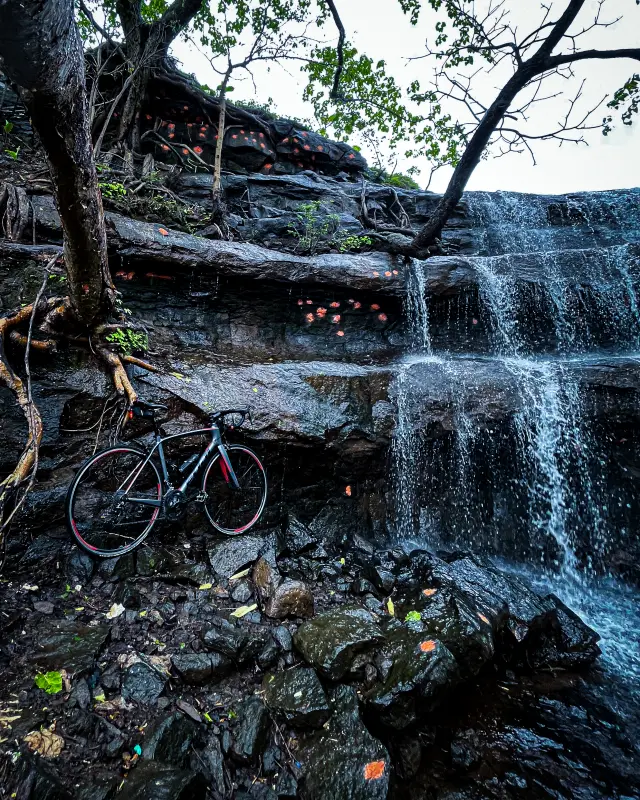
Thanks to all the CyclingMonks Community Contributors, Anurag Kumar, Archisman Banerjee, Ashutosh Anurag, Dhananjai Selvaraj, Gopal Bhavsar, Gaurav Negi and Umang Patel for the images in this article…
If you found this guide useful, don’t forget to check out our other guides: Guide to Riding your First Century and On The Road Repairs That Every Cyclist Should Know

